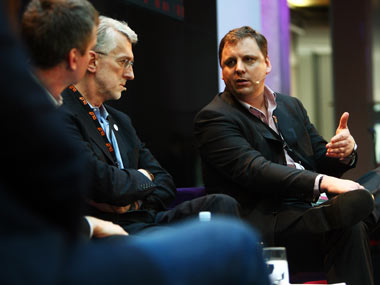Michael Arrington’s position at TechCrunch has finally been clarified by AOL in a statement:
The TechCrunch acquisition has been a success for AOL and for our shareholders, and we are very excited about its future. Michael Arrington, the founder of TechCrunch has decided to move on from TechCrunch and AOL to his newly formed venture fund. Michael is a world-class entrepreneur and we look forward to supporting his new endeavor through our investment in his venture fund. Erick Schonfeld has been named the editor of TechCrunch. TechCrunch will be expanding its editorial leadership in the coming months.
The statement was published in full, with no additional comment, on the TechCrunch site, with the title “ Deciding" To Move On . If the sneer quotes are to be believed, it wasn’t Arrington’s decision at all.
[caption id=“attachment_83114” align=“alignleft” width=“380” caption=“The fact is that there was a conflict of interest and the only way it could be resolved was for Arrington (far Right) to give up his editorial position.Getty Images”]
 [/caption]
[/caption]
The furore started when Arrington announced that he was stepping back from his managing editor role at TechCrunch to launch a new VC fund worth $20 mn, inadvisedly called CrunchFund. The new venture was backed financially by AOL, which invested $10 mn, but many had questions about whether Arrington could fund start-ups and still write about them objectively on TechCrunch.
Feathers were further ruffled by AOL’s CEO, Tim Armstrong as he insinuated that TechCruch wasn’t held to the same rigorous editorial standards as the rest of AOL’s media properties. Confusion ensued as AOL struggled to come up with a suitable response and Arianna Huffington, editor-in-chief of the Huffington Post Media Group, owned by AOL, remained oddly quiet.
It’s not a surprise that Arrington has now been booted out of TechCrunch. Whether or not he felt he could write objectively about the start-up world is neither here nor there. The fact is that there was a conflict of interest and the only way it could be resolved was for Arrington to give up his editorial position. Even without Armstrong putting his foot in his mouth, that was the right thing to do, and it’s what should have been done in the very beginning.
Now it’s all over, Huffington has berated the Wall Street Journal for its coverage of the debacle . Wrote Huffington:
The issue at hand wasn’t about personalities. It was about principle; a very simple fundamental principle about conflicts of interest that every journalistic enterprise adheres to - including the Wall Street Journal, as its former publisher L. Gordon Crovitz points out today. But you wouldn’t know that from the breathless opening grafs of the exceptionally misinformed, substance-lite, and anonymous-quote-riddled piece.
Actually, the issue is about the complete failure of a CEO and his editor-in-chief to understand, from the beginning, that the managing editor of one of their main web properties could not both fund and report on start-ups. All the disclosure in the world can’t solve that conflict of interest.
But instead, Armstrong waded thoughtlessly into the debate with his ill-conceived position that TechCrunch has “different standards"that negated AOL’s prohibition on reports investing in the companies they cover. Indeed, it may have been Armstrong’s own conflict of interest - AOL is both the owner of TechCrunch and an investor in CrunchFund - that clouded his judgment.
Where Huffington has been in all of this is anyone’s guess. Certainly she’s not Arrington’s favourite person right now. Yesterday, he tweeted :
ok @ariannahuff. Let’s go ahead and talk about how this really played out.
Which seems to imply that all may not have been as it seemed. All this palace intrigue, though, can only serve to further demoralise AOL’s editorial staff. If the top brass can’t handle a relatively simple issue as this, how on earth are they going to come up with a winning content strategy?
)